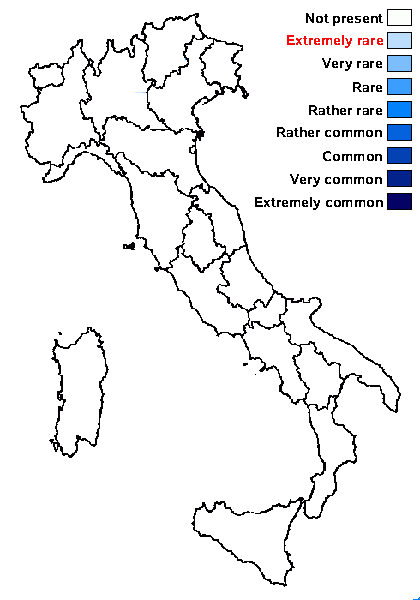Lecidea leucothallina Arnold var. discrepans Rambold & Hertel
in Hertel, Bibl. Lichenol., 58: 163, 1995
Synonyms:
Distribution:
Description: Thallus crustose, episubstratic, 0.2-0.5(-1) mm thick, areolate to squamulose-areolate, the areoles mostly rounded, scattered on a black hypothallus, grey-brown to pale brown. Cortex with an epinecral layer; medulla white, I- Apothecia lecideine, black, sessile, with a slightly concave to slightly convex, smooth, matt, epruinose disc and a persistent to finally excluded proper margin. Proper exciple violet-brown, darker in outer part, usually blue-green in a thin line within, c. 80 µm wide laterally, of parallel-radiating hyphae, the outer cells 2.5-4 µm wide, thin-walled; epithecium brown or olive-brown, P-; hymenium colourless, (45-)50-60 µm high; paraphyses strongly coherent; hypothecium brown to reddish-brown. Asci 8-spored, narrowly clavate, thick-walled, with a K/I+ pale blue tholus and a strongly amyloid, thin apical cushion, surrounded by a I+ blue outer layer, Lecidea-type. Ascospores 1-celled, hyaline, oblong-ellipsoid, 6.6-10.4 x 4-5 µm, 1.5-2.4 times as long as wide. Pycnidia black, immersed. Conidia bacilliform, 11-20 µm long. Photobiont chlorococcoid. Spot tests: medulla K+ yellow, C-, KC-, P+ orange. Chemistry: medulla with stictic acid (major) and norstictic acid (traces)-Note: on hard siliceous rocks, often in sites with a long snow cover in the alpine belt; reported from the Eastern Alps (Austria); to be looked for in the Italian Alps.
Growth form: Crustose
Substrata: rocks
Photobiont: green algae other than Trentepohlia
Reproductive strategy: mainly sexual

Predictive model
Growth form: Crustose
Substrata: rocks
Photobiont: green algae other than Trentepohlia
Reproductive strategy: mainly sexual

Predictive model
 INDEX FUNGORUM
INDEX FUNGORUM
 GBIF
GBIF

